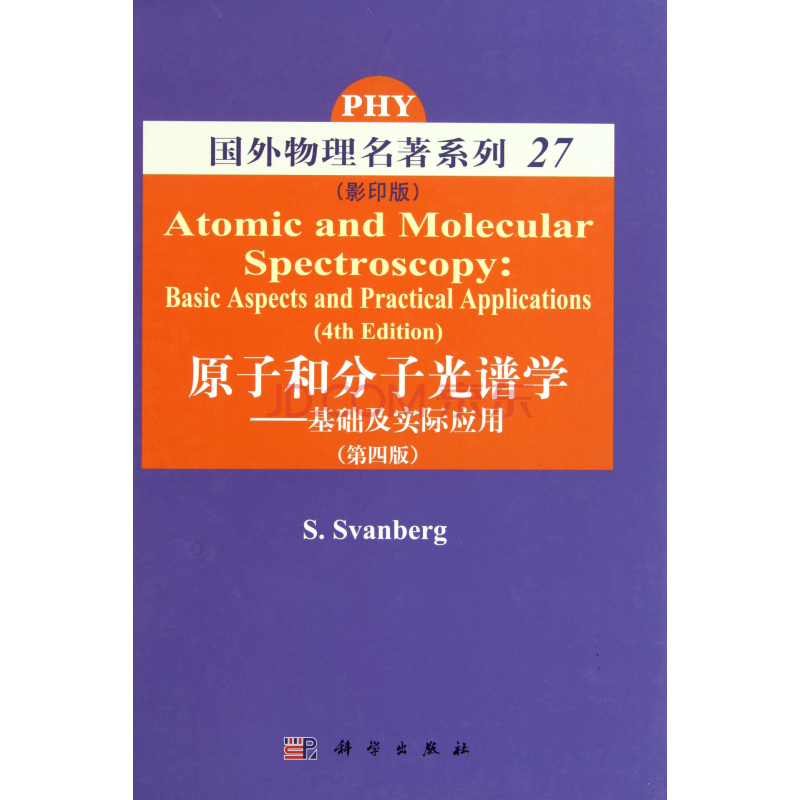《原子和分子光譜學》是2011年6月1日科學出版社社出版的圖書,作者是(美國)斯萬博格(S.Svanberg)。
基本介紹
- 書名:原子和分子光譜學
- 又名:atomic and molecular spectroscopy:basic aspects and practical applications 4th edition
- 作者:(美國)斯萬博格(S.Svanberg)
- ISBN:7030313380, 9787030313386
- 頁數:588頁
- 出版社:科學出版社
- 出版時間:第1版 (2011年6月1日)
- 裝幀:精裝
- 開本:16
內容簡介,目錄,
內容簡介
《原子和分子光譜學:基礎及實際套用(第4版)(影印版)》內容簡介:Awide-rangingreviewofmodemspectroscopictechniquessuchasX-ray,photoelectron,opticalandlaserspectroscopy,andradiofrequencyandmicrowavetechniques.Onthefundamentalsidethebookfocusesonphysicalprinciplesandtheimpactofspectroscopyonourunderstandingofthebuildingblocksofmatter,whileintheareaofapplicationsparticularattentionisgiventothoseinchemicalanalysis,photochemistry,surfacecharacterisation,environmentalandmedicaldiagnostics,remotesensingandastrophyscis.TheFourthEditionalsoprovidesthereaderwithanupdateonlasercoolingandtrapping,Bose-Einsteincondensation,ultra-fastspectroscopy,highpowerlaser/matterinteraction,satellitebasedastronomyandspectroscopicaspectsoflasermedicine.
目錄
1. introduction
2. atomic structure
2.1 one-electron systems
2.2 alkali atoms
2.3 magnetic effects
2.3.1 precessional motion
2.3.2 spin-orbit interaction
2.4 general many-electron systems
2.5 the influence of external fields
2.5.1 magnetic fields
2.5.2 electric fields
2.6 hyperfine structure
2.6.1 magnetic hyperfine structure
2.6.2 electric hyperfine structure
2.7 the influence of external fields (hfs)
2.8 isotopic shifts
3. molecular structure
3.1 electronic levels
3.2 rotational energy
3.3 vibrational energy
3.4 polyatomic molecules
3.5 clusters
3.6 other molecular structures
4. radiation and scattering processes
4.1 resonance radiation
4.2 spectra generated by dipole transitions
4.2.1 atoms
4.2.2 molecules
4.3 rayleigh and raman scattering
4.4 raman spectra
4.4.1 vibrational raman spectra
4.4.2 rotational raman spectra
4.4.3 vibrational-rotational rarnan spectra
4.5 mie scattering
4.6 atmospheric scattering phenomena
4.7 comparison between different radiation and scattering processes
4.8 collision-induced processes
5. spectroscopy of inner electrons
5.1 x-ray spectroscopy
5.1.1 x-ray emission spectroscopy
5.1.2 x-ray absorption spectroscopy
5.1.3 x-ray imaging applications
5.2 photoelectron spectroscopy
5.2.1 xps techniques and results
5.2.2 chemical shifts
5.3 auger electron spectroscopy
6. optical spectroscopy
6.1 light sources
6.1.1 line light sources
6.1.2 continuum light sources
6.1.3 synchrotron radiation
6.1.4 natural radiation sources
6.2 spectral resolution instruments
6.2.1 prism spectrometers
6.2.2 grating spectrometers
6.2.3 the fabry-p~rot interferometer
6.2.4 the fourier transform spectrometer
6.3 detectors
6.4 optical components and materials
6.4.1 interference filters and mirrors
6.4.2 absorption filters
6.4.3 polarizers
6.4.4 optical materials
6.4.5 influence of the transmission medium
6.5 optical methods of chemical analysis
6.5.1 the beer-lambert law
6.5.2 atomic absorption/emission spectrophotometry
6.5.3 burners, flames, sample preparation and measurements
6.5.4 modified methods of atomization
6.5.5 multi-element analysis
6.5.6 molecular spectrophotometry
6.5.7 raman spectroscopy
6.6 optical remote sensing
6.6.1 atmospheric monitoring with passive techniques
6.6.2 land and water measurements with passive techniques
6.7 astrophysical spectroscopy
7. radio-frequency spectroscopy
7.1 resonance methods
7.1.1 magnetic resonance
7.1.2 atomic-beam magnetic resonance
7.1.3 optical pumping
7.1.4 optical double resonance
7.1.5 level-crossing spectroscopy
7.1.6 resonance methods for liquids and solids
7.2 microwave radiometry
7.3 radio astronomy
8. lasers
8.1 basic principles
8.2 coherence
8.3 resonators and mode structure
8.4 fixed-frequency lasers
8.4.1 the ruby laser
8.4.2 four-level lasers
8.4.3 pulsed gas lasers
8.4.4 the he-ne laser
8.4.5 gaseous ion lasers
8.5 tunable lasers
8.5.1 dye lasers
8.5.2 colour-centre lasers
8.5.3 tunable solid-state lasers
8.5.4 tunable co2 lasers
8.5.5 semiconductor lasers
8.6 nonlinear optical phenomena
8.7 ultra-short and ultra-high-power laser pulse generation
8.7.1 short-pulse generation by mode-locking
8.7.2 generation of ultra-high power pulses
9. laser spectroscopy
9.1 basic principles
9.1.1 comparison between conventional light sources and lasers
9.1.2 saturation
9.1.3 excitation methods
9.1.4 detection methods
9.1.5 laser wavelength setting
9.2 doppler-limited techniques
9.2.1 absorption measurements
9.2.2 intracavity absorption measurements
9.2.3 absorption measurements on excited states
9.2.4 level labelling
9.2.5 two-photon absorption measurements
9.2.6 opto-galvanic spectroscopy
9.2.7 single-atom and single-molecule detection
9.2.8 opto-acoustic spectroscopy
9.3 optical double-resonance and level-crossing experiments with laser excitation
9.4 time-resolved atomic and molecular spectroscopy
9.4.1 generation of short optical pulses
9.4.2 measurement techniques for optical transients
9.4.3 background to lifetime measurements
9.4.4 survey of methods of measurement for radiative properties
9.4.5 quantum-beat spectroscopy
9.5 ultrafast spectroscopy
9.5.1 ultrafast measurement techniques
9.5.2 molecular reaction dynamics (femtochemistry)
9.5.3 coherent control
9.6 high-power laser experiments
9.6.1 above threshold ionization (ati)
9.6.2 high harmonic generation
9.6.3 x-ray laser pumping
9.6.4 broadband x-ray generation
9.6.5 relativistic effects and laser accelerators
9.6.6 laser-nuclear interactions and laser-driven fusion
9.7 high-resolution laser spectroscopy
9.7.1 spectroscopy on collimated atomic and ionic beams
9.7.2 saturation spectroscopy and related techniques
9.7.3 doppler-free two-photon absorption
9.8 cooling and trapping of ions and atoms
9.8.1 introduction
9.8.2 ion traps
9.8.3 basic laser cooling in traps
9.8.4 trapped ion spectroscopy
9.8.5 atom cooling and trapping
9.8.6 sub-recoil cooling
9.8.7 atom optics
9.8.8 bose-einstein condensation and "atom lasers"
9.8.9 ultracold fermionic gases
10. laser-spectroscopic applications
10.1 diagnostics of combustion processes
10.1.1 background
10.1.2 laser-induced fluorescence and related techniques
10.1.3 raman spectroscopy
10.1.4 coherent anti-stokes raman scattering
10.1.5 velocity measurements
10.2 laser remote sensing of the atmosphere
10.2.1 optical heterodyne detection
10.2.2 long-path absorption techniques
10.2.3 lidar techniques
10.3 laser-induced fluorescence and raman spectroscopy in liquids and solids
10.3.1 hydrospheric remote sensing
10.3.2 vegetation monitoring
10.3.3 monitoring of surface layers
10.4 laser-induced chemical processes
10.4.1 laser-induced chemistry
10.4.2 laser isotope separation
10.5 spectroscopic aspects of lasers in medicine
10.5.1 thermal interaction of laser light with tissue
10.5.2 photodynamic tumour therapy
10.5.3 tissue diagnostics with laser-induced fluorescence
10.5.4 scattering spectroscopy and tissue transillumination
questions and exercises
references
index

